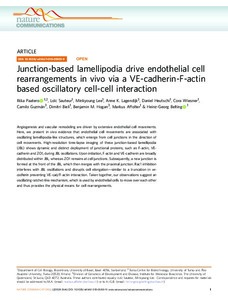Junction-based lamellipodia drive endothelial cell rearrangements in vivo via a VE-cadherin-F-actin based oscillatory cell-cell interaction
Daniel Heutschi; Anne K. Lagendijk; Loïc Sauteur; Dimitri Bieli; Benjamin M. Hogan; Minkyoung Lee; Markus Affolter; Cora Wiesner; Ilkka Paatero; Camilo Guzmán; Heinz-Georg Belting
Junction-based lamellipodia drive endothelial cell rearrangements in vivo via a VE-cadherin-F-actin based oscillatory cell-cell interaction
Daniel Heutschi
Anne K. Lagendijk
Loïc Sauteur
Dimitri Bieli
Benjamin M. Hogan
Minkyoung Lee
Markus Affolter
Cora Wiesner
Ilkka Paatero
Camilo Guzmán
Heinz-Georg Belting
NATURE PUBLISHING GROUP
Julkaisun pysyvä osoite on:
https://urn.fi/URN:NBN:fi-fe2021042719723
https://urn.fi/URN:NBN:fi-fe2021042719723
Tiivistelmä
Angiogenesis and vascular remodeling are driven by extensive endothelial cell movements. Here, we present in vivo evidence that endothelial cell movements are associated with oscillating lamellipodia-like structures, which emerge from cell junctions in the direction of cell movements. High-resolution time-lapse imaging of these junction-based lamellipodia (JBL) shows dynamic and distinct deployment of junctional proteins, such as F-actin, VE-cadherin and ZO1, during JBL oscillations. Upon initiation, F-actin and VE-cadherin are broadly distributed within JBL, whereas ZO1 remains at cell junctions. Subsequently, a new junction is formed at the front of the JBL, which then merges with the proximal junction. Rac1 inhibition interferes with JBL oscillations and disrupts cell elongation-similar to a truncation in ve-cadherin preventing VE-cad/F-actin interaction. Taken together, our observations suggest an oscillating ratchet-like mechanism, which is used by endothelial cells to move over each other and thus provides the physical means for cell rearrangements.
Kokoelmat
- Rinnakkaistallenteet [19207]
